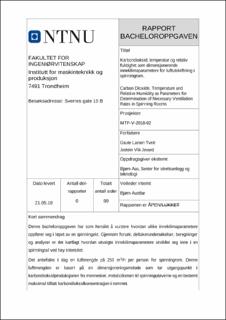| dc.description.abstract | Ventilation requirements in sport facilities are subject for discussion in Norway. According to SIAT (Centre for Sport Facilities and Technology), sport facilities often have to follow strict requirements regarding function, quality, installations and equipment. Yet there are no relevant education within the field of planning, building and operating sport facilities (SIAT, 2018). Today a recommendation from the Norwegian Ministry of Culture dictates both temperature and ventilation rates. The recommendations are supposed to secure sufficient ventilation rates and provide the possibility to adjust air flow to every situation. A challenge occurs when the recommendations are used as requirements, even though that is not the purpose. As a result, this paper challenges the recommendation and uses samples from a spinning room during exercise to analyse indoor air quality.
Carbon dioxide (CO2) concentration has been used for decades to indicate indoor air quality and in turn decide necessary ventilation rates based on metabolism and CO2 generations from occupants. This paper reviews today’s method and compare it with results from field tests in Trondheim, Norway. Spinning exercise was chosen as the activity because of its high intensity level and recommended ventilation rates. Participants produce a lot of contaminations regarding CO2, sweat and heat, resulting in increased humidity and temperature in the room. Analyses from the field tests show that CO2 fails to indicate how humidity evolves during the test, and its usefulness therefore diminish dramatically. The tests also show coherence between ventilation rates and humidity. Regarding to the perception of indoor air quality, temperature and humidity have more importance than CO2. According to earlier research (Fang, Clausen og Fanger, 1998), significant linear correlations exist between acceptability and enthalpy of the air. Therefore a model for regulating air flow based on enthalpy was developed based on the results from the field tests.
This paper concludes that, based on the results from tests, CO2 is not the correct parameter to indicate indoor air quality in high intensity sport facilities. Instead, humidity and temperature should be used as parameters for determination of necessary ventilation rates. Even though the recommendation for ventilation rates is based on inadequate basis, it provides necessary air flow to keep humidity and temperature at accepted levels. This paper suggests lowering air flow to a level that is still sufficient. Tests should be done to asses when critical level are met. | en_US |
